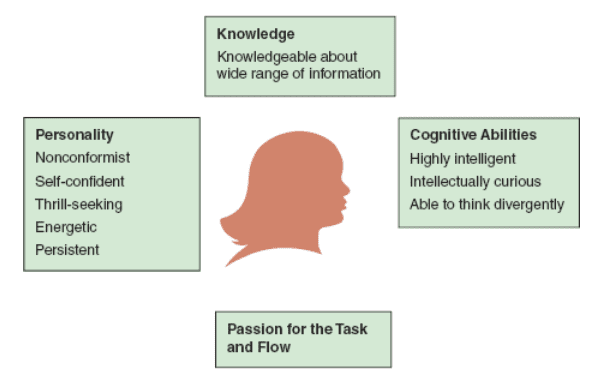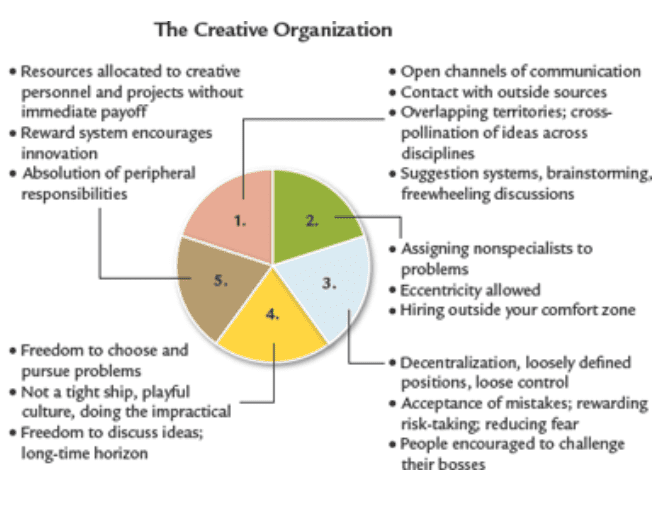Personality Traits That Set Creative Leaders Apart From Bureaucratic Non-Creatives in Problem Solving
Creativity is a key factor for success in any organization, but it is especially crucial in entrepreneurship. Starting a new company is one of the most opportunity-driven endeavors an individual can undertake, requiring a unique set of skills and a creative mindset. Personally, creativity has always been an inherent part of who I am. Growing up, I faced unique challenges that required creative solutions, such as helping to take care of my two younger sisters with learning disabilities while my parents were going through a divorce. A place of peace for me was spending time alone in the woods with my German shepherd, Lucy, and playing sports. These experiences taught me independence, resilience, and creative problem-solving skills that I still rely on today.
As a scholar specializing in the impact of personality on organizational citizenship behavior, my research has shown that leaders who prioritize employee well-being and foster a positive work culture inspire creativity and innovation. By encouraging an open-minded and collaborative environment, leaders can inspire their team to approach challenges with a creative and innovative mindset, leading to increased productivity and success for the organization. Understanding this relationship can help leaders develop effective strategies that encourage creativity and innovation within their team.
Bridget van Kralingen’s inspiring leadership at IBM Global Markets and her dedication to innovation motivates me to be creative in any environment or corporate structure. Her focus on new business models, cloud platforms, artificial intelligence, and blockchain highlights the importance of staying up-to-date with technological advancements and not being afraid to take risks. Her belief in the value of learning from mistakes and using them as a means of moving forward has also encouraged me to approach problem-solving with an open mind and embrace new ideas. I am intrigued to know what inspired Bridget to remain at IBM and how the company managed to motivate and support her in making such a significant industry impact.

The Independent and Adventurous Nature of Creative Problem Solvers
Creative problem solvers are characterized by an independent and nonconformist mindset that prioritizes alternative solutions to problems over group consensus. They are comfortable thinking differently, exploring unconventional methods for problem-solving, and often possess an adventurous spirit as thrill-seekers and risk-takers. Successful creative leaders share these traits and are willing to take calculated risks to achieve their goals. Organizations can foster this mindset by promoting personal traits such as creativity and curiosity and developing a culture that encourages risk-taking and unconventional thinking.
Independent and adventurous nature of creative problem solvers:
- Possesses an independent and nonconformist mindset
- Prioritizes searching for alternative solutions to issues over attaining group consensus
- Does not rely on strong approval from the group to validate their ideas
- Thinks outside of the box and explores unconventional methods for problem-solving
- Is a thrill-seeker and risk-taker, finding excitement in developing imaginative and innovative solutions to complex stumbling blocks
- Is willing to take risks and try new things, pursuing ideas even if they are considered risky or unorthodox
- Has a positive self-image and belief in their ability to solve problems creatively
- Has strong problem-solving skills and the ability to develop imaginative solutions to complex obstacles
- Is persistent and able to handle criticism
- Is comfortable with ambiguity and able to tolerate isolation when developing ideas.
Choosing effective methods for managing creative workers is crucial for organizations looking to foster innovation and success. To do so, it is important to provide creative workers with the tools and resources necessary for their work to stand out, while also allowing them the flexibility and freedom to explore new ideas and approaches. When turning down an idea, it is important to provide gentle feedback, allowing the creative worker to understand why their idea was not accepted and learn from the experience. Finally, it can be beneficial to employ creative individuals in managerial and evaluation roles, as they have a better understanding of the unique challenges faced by creative workers and can help create a supportive and empowering work environment.
To learn more about how to mange the next generation of leaders through fostering an environment of creativity, please see this article: Adopting Creativity and Innovation for Next-Generation Business Leaders
The Importance of Personality Factors in Creative Problem Solving
Self-confidence has always been a crucial factor for enhancing my creativity. As an entrepreneur, I have had to believe in my ideas and abilities to overcome the doubts and criticism of others. Having a positive self-image, I am willing to accept criticism and work in isolation to develop my ideas. I focus my self-confidence on my ability to solve problems creatively and develop innovative solutions. I understand that blindly self-confidence can hinder creativity, but a healthy level of self-confidence can inspire and drive me towards success.

Creative leaders possess unique qualities that set them apart from their less creative counterparts. They are inclined to challenge the status quo and are adaptable enough to approach problems from different angles. Here are the key characteristics of creative leaders:
- Knowledge: Creative leaders have a broad range of information that includes facts and observations, allowing them to combine multiple concepts to generate new ideas.
- Cognitive abilities: They have above-average intelligence and maintain a youthful curiosity. They have a unique blend of left-brain and right-brain thinking and can spot opportunities others might overlook.
- Personality: Creative leaders have a positive self-image without being blindly self-confident. They are nonconformists, intellectually curious, persistent, and comfortable dealing with ambiguity.
- Passion for the task and flow: They have a passion for their work, high intrinsic motivation, and an intense concentration that enables them to experience flow.
In my experience as a creative leader, I have realized that personal characteristics play a significant role in facilitating my creative behavior. However, I have also discovered that the proper environment is equally vital in triggering that behavior. See the book Triggers: Creating Behavior That Lasts–Becoming the Person You Want to Be by Mark Reiter and Marshall Goldsmith. It emphasizes the importance of environmental triggers and how they impact our behavior, including the creative behavior of leaders.
Qualities of Creative Leaders vs. Bureaucratic Non-Creatives
I have always enjoyed dealing with ambiguity and chaos. I have found that ambiguity can be a powerful stimulant to the imagination, and that it can lead to some of the most innovative solutions. In contrast, less creative people tend to become quickly frustrated when task descriptions are unclear and disorder exists.
I have also observed that individuals who are bureaucratic and non-creative tend to be risk-averse and avoid taking risks, which can limit their ability to innovate. They often prefer structured and orderly environments, which can stifle creativity and innovation. These individuals may also lack persistence and give up easily when faced with obstacles. Moreover, they may prioritize their own interests over those of the organization and engage in unethical behavior, which can hinder innovation and creative problem-solving within the organization.
In my experience, it is essential to maintain a positive attitude and avoid perfectionism when striving for creativity. As the famous artist Salvador Dali once said, “Have no fear of perfection – you’ll never reach it.” By projecting oneself into a positive frame of mind, even when faced with challenging tasks such as cutting costs, one can foster a creative and innovative environment that drives organizational success.

Enhance your Creative Leadership:
- Overcome the self-perception that you are not creative.
- Practice creativity-enhancing exercises regularly, such as creative photography, asking “What-if” questions, puzzles, joke writing, or learning a second language.
- Stay alert to opportunities that others may overlook.
- Maintain an enthusiastic and positive attitude, even when performing judicial tasks.
- Maintain and use a systematic place for recording your ideas.
- Seek advice from someone outside your field to gain new perspectives.
- Play the roles of explorer, artist, judge, and lawyer in creative problem-solving.
- Engage in appropriate physical exercise to stimulate creativity.
- Solicit feedback on your performance to sharpen your imagination.
Practices that Enhance Creativity in your Organization:
- Hire creative people from outside and within for an innovative environment.
- Challenge people intellectually without overwhelming them.
- Empower workers by granting freedom to choose the best method.
- Provide ample resources, including time and money, for creativity.
- Design workgroups that are diverse, supportive, and encourage face-to-face contact.
- Encourage innovative thinking that improves performance.
- Support creativity at all levels with a reward system and organizational support.
- Foster positive relationships between leaders and creative workers.
- Provide financial rewards for innovation and sustaining a climate of creativity.
In conclusion, personality factors play a critical role in creative problem solving, and as a leader, I believe that creativity and willingness to innovate may be one of my most valuable traits. By fostering a culture of creativity and innovation, organizations can attract and retain creative leaders who will drive success and achieve their goals and objectives. For me, being creative is not just a skill I learned in school; it’s part of my personality that has been developed over time through my experiences and willingness to try new things. As a leader, I am comfortable with ambiguity and have found that it can lead to some of the most innovative solutions to problems. I also understand the importance of encouraging my team to do the same. By promoting a culture of collaboration and open-mindedness, I believe we can unlock the full potential of our organizations and achieve great success.
Listen to our podcast on Understanding Individual Behavior for insights on how to effectively manage and lead creative problem solvers in yourself, your team, or your family.
